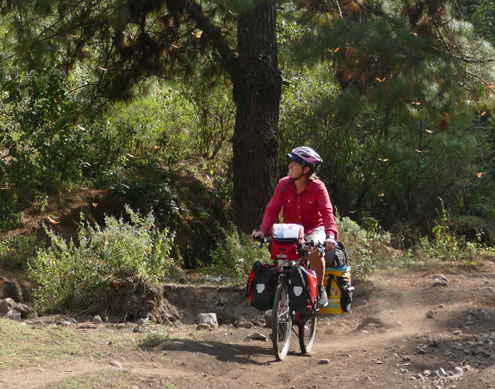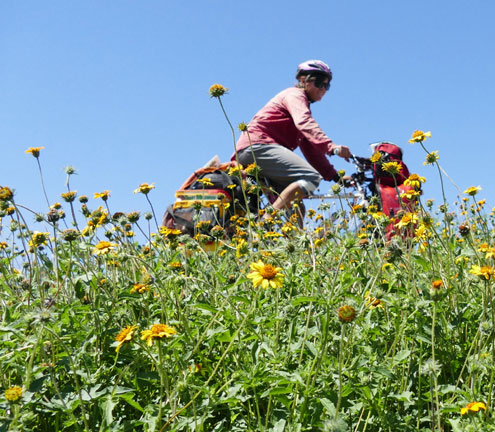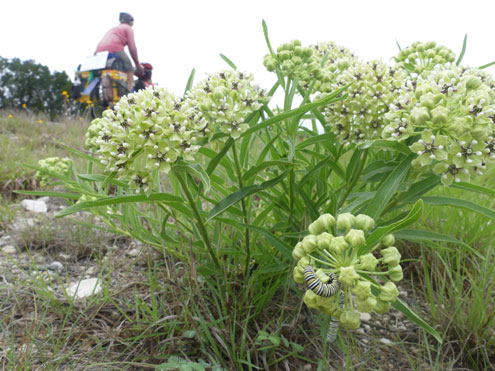Each spring millions of monarch butterflies leave the mountains of Central Mexico, where they survived the winter, to begin their annual migration north. This spring they are accompanied by cyclist Sara Dykman (age 32) from Kansas who is biking 10,000 miles from the monarch overwintering colonies in Mexico to Canada …and back... with the butterflies. Or as Dykman would say, "Butterbiking with the butterflies."
On April 15, 2017, Dykman will be making a stop at Hagerman National Wildlife Refuge to join the refuge’s butterfly walk from 11:00 a.m.-1:00 p.m. She welcomes folks to come see her gear and learn how biking 10,000 miles with butterflies is possible. Then, at 2:00 p.m., she will present all about her trip and the monarch migration. Both events are free to the public, and more information can be found at www.FriendsOfHagerman.com.

Hagerman is just one of many stops on Dykman’s bicycle migration, including presentations to school kids. During her presentation, the students look at photos and listen to stories from her trip. They learned all about the unique monarch migration, and tried out some of her camping gear. “It is so rewarding to connect my adventures to students,” said Dykman. “I want to show people how incredible the world is and be an example of what it means to follow your dreams and take care of the planet.”
These rest stops and presentations are key to the success of Dykman’s adventure. “As much as I love biking, what I will remember most are the people that invite me in and the students that have hundreds of questions and can’t wait to hear more,” reflected Dykman. “They motivate me to keep moving.”

And keep moving she must. In order to follow the migration, Dykman must cover about 300 miles per week on a bicycle loaded down with everything she needs for life on the road. From camping equipment to presentation materials, her bike is heavy and she moves slowly following the monarch migration while raising awareness about the importance of monarchs and threats to this iconic species. “The monarch migration is such an incredible migration,” boasted Dykman. “Not only are these iconic butterflies flying thousands of miles, but it is a multigenerational, multinational migration. And unless people along the route plant native nectar plants and milkweed in their gardens and on their lands and lawns… the monarchs are likely to go extinct.”
The eastern monarch populations have been in steady decline since counting began in the 1990s. In 1996 monarchs covered 21 hectares of the Mexican Oyamel Fir Forest. By 2014, monarchs covered only 0.67 hectares. This 80% decline can be attributed to habitat loss and climate change.
Adding to the conservation dilemma is the fact that monarchs call three countries home. Monarchs depend on Mexico, the United States, and Canada to work together to protect the migration. “The future of the monarch migration is in the hands of people from all three countries,” reported Dykman. “In Mexico, people need to protect the Oyamel Fir forest that the monarchs depend on to survive the winter, and in the United States and Canada, people need to plant milkweed.”

Milkweed is the only food source of the monarch caterpillars, and gives the monarchs the toxins they needs to be poisonous and avoid being eaten by most predators. Milkweed has been in a fast decline as industrial farming uses more broad-spectrum herbicides and land development encroaches on wild lands. Monarch Watch, a University of Kansas monarch education program, estimates that 6,000 acres of milkweed habitat are lost daily to development.
However there is some good news, because unlike many species that need untouched wilderness to thrive, monarchs simply need waystations, or gardens that have milkweed plants to lay their eggs and feed their caterpillars, as well as flowering plants that provide monarchs and other pollinators with nectar. “Every garden adds up, and every garden is part of the solution,” Dykman emphasized. “Schools, city halls, churches, parks, farms, and neighborhoods are planting milkweed and native flowering plants to help save the migration.”
The efforts of so many people have made the monarch an iconic symbol of education, conservation and team work. Unless people from Mexico, the United States, and Canada can work together to implement conservation strategies, the monarch migration could disappear from the planet. “I am biking to raise awareness and encourage people to plant native gardens with milkweed. Be part of the solution and be part of the migration,” said Dykman. “The future of the monarch is in the hands of all North Americans”
Follow Dykman’s videos, photos, blogs, and a daily progress map as she Butterbikes with the butterflies at www.beyondabook.org.